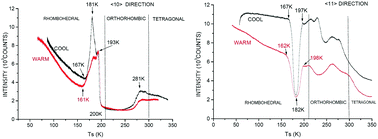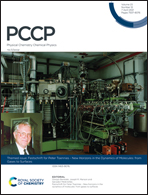Helium atom scattering from potassium tantalate/niobate(001) surfaces
Abstract
The results of He atom scattering experiments on KTa0.48Nb0.52O3(001) surfaces are presented and compared with similar experiments on mixed potassium tantalate/niobate perovskites with lower concentrations of Nb. The results are puzzling, unique and intriguing. Angular distributions of the He scattering intensities (the He surface diffraction pattern) are found to be very similar to those obtained from targets with lower Nb fractions. However, drift spectra (the intensity of the He specular reflection as a function of the He wave vector) are not. Whereas the drift spectra in the 〈10〉 azimuth do resemble those of the 0, 6 and 10% Nb fraction targets, in the 〈11〉 azimuth they are more similar to the strange drift spectra found from the 30% Nb-doped targets. Most intriguing are the surface temperature scans (the He specular intensity as a function of the target surface temperature); for they are quite distinct from those with lower Nb fractions. Finally, the inelastic He scattering experiments provide phonon dispersion results that are similar in most respects to those found for the lower Nb level samples. In particular, the most prominent feature is an Einstein-like mode at about 13.5 meV which spans the entire surface Brillouin zone in both 〈10〉 and 〈11〉 azimuths.

- This article is part of the themed collection: Festschrift for Peter Toennies - New Horizons in the Dynamics of Molecules: from Gases to Surfaces


 Please wait while we load your content...
Please wait while we load your content...